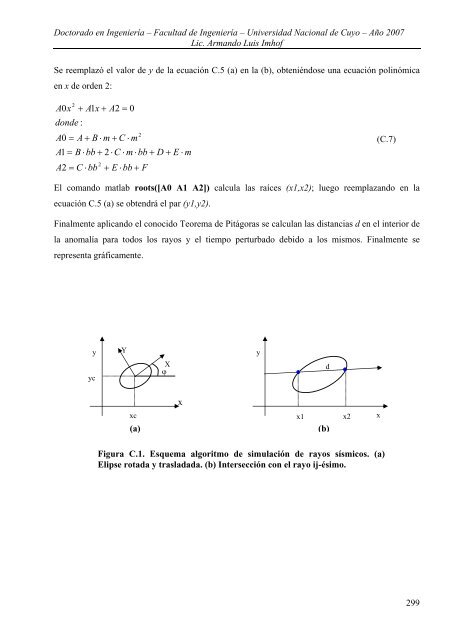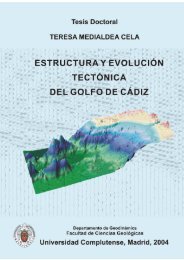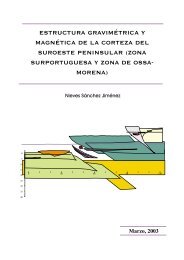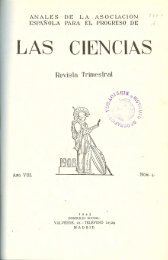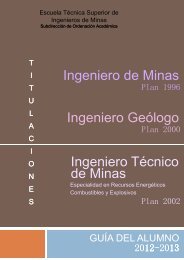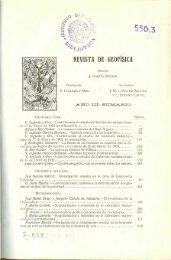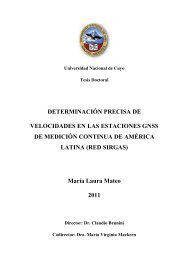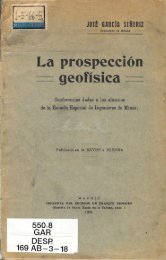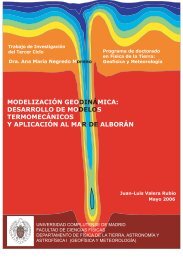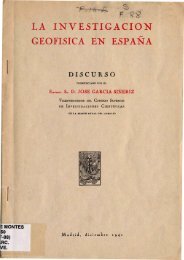- Page 1:
CARACTERIZACIÓN DE ARENAS Y GRAVAS
- Page 4 and 5:
Imhof, Armando Luis Caracterizació
- Page 7:
Hace años leía mucho sobre las ep
- Page 11 and 12:
DEDICACTORIA RECONOCIMIENTOS. TABLA
- Page 13 and 14:
2.4.5 Factor de Acoplamiento Electr
- Page 15 and 16:
5.7 Conclusiones. 135 CAPÍTULO 6.
- Page 17 and 18:
LISTA DE PLANILLAS MATEMÁTICAS Pla
- Page 19:
LISTA DE TABLAS Tabla pág. 1.1 Pro
- Page 22 and 23:
xii diferentes presiones efectivas
- Page 24 and 25:
4.12 Coordenadas xij , xij , yij
- Page 26 and 27:
xvi
- Page 28 and 29:
x : vector solución de velocidade
- Page 30 and 31:
En el capítulo 6 se resume lo estu
- Page 32 and 33:
In chapter 6 all the inversion tech
- Page 34 and 35:
elásticas en el rango de frecuenci
- Page 36 and 37:
• Matemática: ecuaciones diferen
- Page 38 and 39:
Doctorado en Ingeniería - Facultad
- Page 40 and 41:
Doctorado en Ingeniería - Facultad
- Page 42 and 43:
Doctorado en Ingeniería - Facultad
- Page 44 and 45:
Doctorado en Ingeniería - Facultad
- Page 46 and 47:
Doctorado en Ingeniería - Facultad
- Page 48 and 49:
Doctorado en Ingeniería - Facultad
- Page 50 and 51:
Doctorado en Ingeniería - Facultad
- Page 52 and 53:
Doctorado en Ingeniería - Facultad
- Page 54 and 55:
Doctorado en Ingeniería - Facultad
- Page 56 and 57:
Doctorado en Ingeniería - Facultad
- Page 58 and 59:
Doctorado en Ingeniería - Facultad
- Page 60 and 61:
Doctorado en Ingeniería - Facultad
- Page 62 and 63:
Doctorado en Ingeniería - Facultad
- Page 64 and 65:
Doctorado en Ingeniería - Facultad
- Page 66 and 67:
Doctorado en Ingeniería - Facultad
- Page 68 and 69:
Doctorado en Ingeniería - Facultad
- Page 70 and 71:
Doctorado en Ingeniería - Facultad
- Page 72 and 73:
Doctorado en Ingeniería - Facultad
- Page 74 and 75:
Doctorado en Ingeniería - Facultad
- Page 76 and 77:
Doctorado en Ingeniería - Facultad
- Page 78 and 79:
Doctorado en Ingeniería - Facultad
- Page 80 and 81:
Doctorado en Ingeniería - Facultad
- Page 82 and 83:
Doctorado en Ingeniería - Facultad
- Page 84 and 85:
Doctorado en Ingeniería - Facultad
- Page 86 and 87:
Doctorado en Ingeniería - Facultad
- Page 88 and 89:
Doctorado en Ingeniería - Facultad
- Page 90 and 91:
Doctorado en Ingeniería - Facultad
- Page 92 and 93:
Doctorado en Ingeniería - Facultad
- Page 94 and 95:
Doctorado en Ingeniería - Facultad
- Page 96 and 97:
Doctorado en Ingeniería - Facultad
- Page 98 and 99:
Doctorado en Ingeniería - Facultad
- Page 100 and 101:
Doctorado en Ingeniería - Facultad
- Page 102 and 103:
Doctorado en Ingeniería - Facultad
- Page 104 and 105:
Doctorado en Ingeniería - Facultad
- Page 106 and 107:
Doctorado en Ingeniería - Facultad
- Page 108 and 109:
Doctorado en Ingeniería - Facultad
- Page 110 and 111:
Doctorado en Ingeniería - Facultad
- Page 112 and 113:
Doctorado en Ingeniería - Facultad
- Page 114 and 115:
Doctorado en Ingeniería - Facultad
- Page 116 and 117:
Doctorado en Ingeniería - Facultad
- Page 118 and 119:
Doctorado en Ingeniería - Facultad
- Page 120 and 121:
Doctorado en Ingeniería - Facultad
- Page 122 and 123:
Doctorado en Ingeniería - Facultad
- Page 124 and 125:
Doctorado en Ingeniería - Facultad
- Page 126 and 127:
Doctorado en Ingeniería - Facultad
- Page 128 and 129:
Doctorado en Ingeniería - Facultad
- Page 130 and 131:
Doctorado en Ingeniería - Facultad
- Page 132 and 133:
Doctorado en Ingeniería - Facultad
- Page 134 and 135:
Doctorado en Ingeniería - Facultad
- Page 136 and 137:
Doctorado en Ingeniería - Facultad
- Page 138 and 139:
Doctorado en Ingeniería - Facultad
- Page 140 and 141:
Doctorado en Ingeniería - Facultad
- Page 142 and 143:
Doctorado en Ingeniería - Facultad
- Page 144 and 145:
Doctorado en Ingeniería - Facultad
- Page 146 and 147:
Doctorado en Ingeniería - Facultad
- Page 148 and 149:
Doctorado en Ingeniería - Facultad
- Page 150 and 151:
114 Doctorado en Ingeniería - Facu
- Page 152 and 153:
Doctorado en Ingeniería - Facultad
- Page 154 and 155:
Doctorado en Ingeniería - Facultad
- Page 156 and 157:
Doctorado en Ingeniería - Facultad
- Page 158 and 159:
Doctorado en Ingeniería - Facultad
- Page 160 and 161:
Doctorado en Ingeniería - Facultad
- Page 162 and 163:
Doctorado en Ingeniería - Facultad
- Page 164 and 165:
Doctorado en Ingeniería - Facultad
- Page 166 and 167:
Doctorado en Ingeniería - Facultad
- Page 168 and 169:
Doctorado en Ingeniería - Facultad
- Page 170 and 171:
Doctorado en Ingeniería - Facultad
- Page 172 and 173:
Doctorado en Ingeniería - Facultad
- Page 174 and 175:
Doctorado en Ingeniería - Facultad
- Page 176 and 177:
Doctorado en Ingeniería - Facultad
- Page 178 and 179:
Doctorado en Ingeniería - Facultad
- Page 180 and 181:
Doctorado en Ingeniería - Facultad
- Page 182 and 183:
Doctorado en Ingeniería - Facultad
- Page 184 and 185:
Doctorado en Ingeniería - Facultad
- Page 186 and 187:
Doctorado en Ingeniería - Facultad
- Page 188 and 189:
Doctorado en Ingeniería - Facultad
- Page 190 and 191:
Doctorado en Ingeniería - Facultad
- Page 192 and 193:
Doctorado en Ingeniería - Facultad
- Page 194 and 195:
Doctorado en Ingeniería - Facultad
- Page 196 and 197:
Doctorado en Ingeniería - Facultad
- Page 198 and 199:
Doctorado en Ingeniería - Facultad
- Page 200 and 201:
Velocidad promedio [m/s] Velocidad
- Page 202 and 203:
Doctorado en Ingeniería - Facultad
- Page 204 and 205:
Doctorado en Ingeniería - Facultad
- Page 206 and 207:
Doctorado en Ingeniería - Facultad
- Page 208 and 209:
Doctorado en Ingeniería - Facultad
- Page 210 and 211:
Doctorado en Ingeniería - Facultad
- Page 212 and 213:
Doctorado en Ingeniería - Facultad
- Page 214 and 215:
Doctorado en Ingeniería - Facultad
- Page 216 and 217:
Doctorado en Ingeniería - Facultad
- Page 218 and 219:
Doctorado en Ingeniería - Facultad
- Page 220 and 221:
Doctorado en Ingeniería - Facultad
- Page 222 and 223:
Doctorado en Ingeniería - Facultad
- Page 224 and 225:
Doctorado en Ingeniería - Facultad
- Page 226 and 227:
Doctorado en Ingeniería - Facultad
- Page 228 and 229:
Doctorado en Ingeniería - Facultad
- Page 230 and 231:
Doctorado en Ingeniería - Facultad
- Page 232 and 233:
Doctorado en Ingeniería - Facultad
- Page 234 and 235:
Doctorado en Ingeniería - Facultad
- Page 236 and 237:
Doctorado en Ingeniería - Facultad
- Page 238 and 239:
Doctorado en Ingeniería - Facultad
- Page 240 and 241:
Doctorado en Ingeniería - Facultad
- Page 242 and 243:
Doctorado en Ingeniería - Facultad
- Page 244 and 245:
Doctorado en Ingeniería - Facultad
- Page 246 and 247:
Doctorado en Ingeniería - Facultad
- Page 248 and 249:
Doctorado en Ingeniería - Facultad
- Page 250 and 251:
Doctorado en Ingeniería - Facultad
- Page 252 and 253:
Doctorado en Ingeniería - Facultad
- Page 254 and 255:
Doctorado en Ingeniería - Facultad
- Page 256 and 257:
Doctorado en Ingeniería - Facultad
- Page 258 and 259:
Doctorado en Ingeniería - Facultad
- Page 260 and 261:
Doctorado en Ingeniería - Facultad
- Page 262 and 263:
Doctorado en Ingeniería - Facultad
- Page 264 and 265:
Doctorado en Ingeniería - Facultad
- Page 266 and 267:
Doctorado en Ingeniería - Facultad
- Page 268 and 269:
Doctorado en Ingeniería - Facultad
- Page 270 and 271:
Doctorado en Ingeniería - Facultad
- Page 272 and 273:
Doctorado en Ingeniería - Facultad
- Page 274 and 275:
Doctorado en Ingeniería - Facultad
- Page 276 and 277:
Doctorado en Ingeniería - Facultad
- Page 278 and 279:
Doctorado en Ingeniería - Facultad
- Page 280 and 281:
Doctorado en Ingeniería - Facultad
- Page 282 and 283:
Doctorado en Ingeniería - Facultad
- Page 284 and 285: Doctorado en Ingeniería - Facultad
- Page 286 and 287: Doctorado en Ingeniería - Facultad
- Page 288 and 289: Doctorado en Ingeniería - Facultad
- Page 290 and 291: Doctorado en Ingeniería - Facultad
- Page 292 and 293: Doctorado en Ingeniería - Facultad
- Page 294 and 295: Doctorado en Ingeniería - Facultad
- Page 296 and 297: Doctorado en Ingeniería - Facultad
- Page 298 and 299: Doctorado en Ingeniería - Facultad
- Page 300 and 301: Doctorado en Ingeniería - Facultad
- Page 302 and 303: Doctorado en Ingeniería - Facultad
- Page 304 and 305: Doctorado en Ingeniería - Facultad
- Page 306 and 307: Doctorado en Ingeniería - Facultad
- Page 308 and 309: Doctorado en Ingeniería - Facultad
- Page 310 and 311: Doctorado en Ingeniería - Facultad
- Page 312 and 313: Doctorado en Ingeniería - Facultad
- Page 314 and 315: Doctorado en Ingeniería - Facultad
- Page 316 and 317: Doctorado en Ingeniería - Facultad
- Page 318 and 319: Doctorado en Ingeniería - Facultad
- Page 320 and 321: Doctorado en Ingeniería - Facultad
- Page 322 and 323: Doctorado en Ingeniería - Facultad
- Page 324 and 325: Doctorado en Ingeniería - Facultad
- Page 326 and 327: Doctorado en Ingeniería - Facultad
- Page 328 and 329: Doctorado en Ingeniería - Facultad
- Page 330 and 331: Doctorado en Ingeniería - Facultad
- Page 332 and 333: Doctorado en Ingeniería - Facultad
- Page 336 and 337: Doctorado en Ingeniería - Facultad
- Page 338 and 339: Doctorado en Ingeniería - Facultad
- Page 340 and 341: Doctorado en Ingeniería - Facultad


